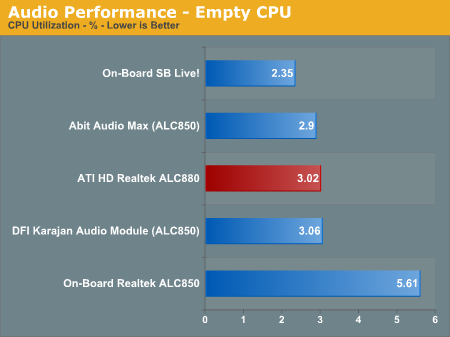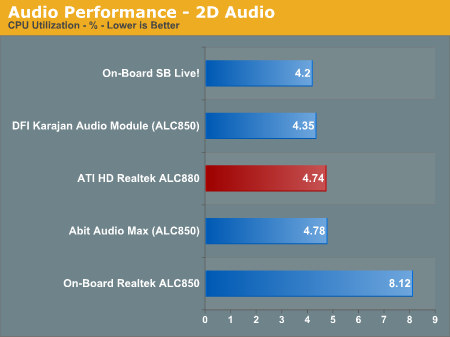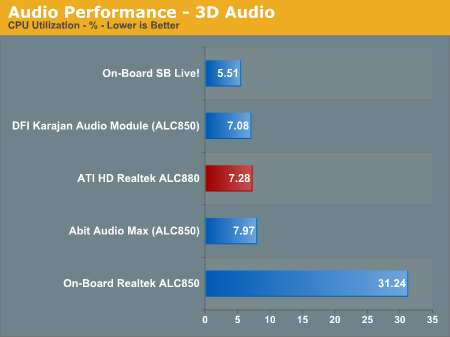Sapphire PURE Innovation - ATI's Chipset for the AMD Enthusiast
by Wesley Fink on July 29, 2005 12:05 AM EST- Posted in
- Motherboards
Audio Performance
For audio testing, we used Rightmark 3D Sound CPU utilization test, which is the same benchmark run in our earlier nForce4 SLI and Ultra roundups. This benchmark measures the overhead or CPU utilization required by a codec or hardware audio chip.



It is very important to point out that the ATI Crossfire AMD is the first Athlon 64 board to deliver Azalia High Definition audio. Those who have been complaining about the poor AC'97 audio present on most AMD boards should be very pleased to find Azalia HD on the ATI.
We did some subjective listening tests with the ATI Azalia HD through a Dolby amplifier and a 5.1 speaker setup. The ATI Azalia HD was in a completely different league from the other audio solutions that we have tested on Athlon 64. Noise was virtually nonexistent, and the imaging and depth were superb when listening to Orff's Carmina Burana. The same CD sounded thin, noisy, and artificial through a more common ALC850 fed to the same Dolby amp and 5.1 speakers. This is not to say that the Azalia HD is at the same level as the very best audio cards, but it is a lot closer than what we think many of you imagine.
As the first implementation of Azalia HD audio on A64, the HD Realtek ALC880 features:
- High-performance DACs with 100dB S/N ratio
- ADCs with S/N ratio greater than 85dB
- Meets performance requirements for audio on PC2001 systems
- 8 DAC channels support 16/20/24-bit PCM format for 7.1 audio solution
- 3 stereo ADCs support 16/20-bit PCM format, two for microphone array, one for legacy mixer recording
- Supports 44.1K/48K/96K/192kHz DAC sample rate
- All ADCs support 44.1K/48K/96K sample rate
- Applicable for 4-channel/192kHz and 6-channel/96kHz DVD-Audio solutions
- Up to four channels of microphone input are supported for AEC/BF application
- High-quality differential CD input
- Supports Power Off CD function
- Supports external PCBEEP input and built-in BEEP generator
- PCBEEP Pass-Through when link is in RESET state
- Software selectable 2.5V/3.75V VREFOUT
- Six VREFOUTs are supported by default, with additional four VREFOUTs available by sharing unused analog I/O pins
- Two GPI (General Purpose Input) jack detection pins (each designed to detect 4 jacks)
- 16/20/24-bit S/PDIF-OUT supports 44.1K/48K/96kHz sample rate
- 16/20/24-bit S/PDIF-IN supports 44.1K/48K/96kHz sample rate
- Optional EAPD (External Amplifier Power Down) supported
- Power support: Digital: 3.3V; Analog: 3.3V/5.0V
- Power management and enhanced power saving features
- Compatible with AC'97
- 48-pin LQFP package (lead-free package also available)
- Reserve analog mixer architecture for backward compatibility with AC'97
- -64dB ~ +30dB with 1dB resolution of mixer gain to achieve finer volume control
- Impedance sensing capability for each re-tasking jack
- All analog jacks are stereo input and output re-tasking for analog plug & play
- Built-in headphone amplifier for each re-tasking jack
- Supports external volume knob control
- Supports 2 GPIOs (General Purpose Input/Output) for customized applications
- Hardware de-scrambling for DVD-Audio Content protection
- Meets Microsoft WHQL/WLP 2.0 audio requirements
- EAXTM 1.0 & 2.0 compatible
- Direct Sound 3DTM compatible
- A3DTM compatible
- I3DL2 compatible
- HRTF 3D Positional Audio
- Emulation of 26 sound environments to enhance gaming experience
- 10 Software Equalizer Bands
- Voice Cancellation and Key Shifting in Karaoke mode
- Realtek Media Player
- Enhanced Configuration Panel and device sensing wizard to improve user experience
- Microphone Acoustic Echo Cancellation (AEC) and Beam Forming (BF) technology for voice application
- Mono/Stereo Microphone noise suppression
- ALC880D features Dolby® Digital Live output for consumer equipment










52 Comments
View All Comments
Avalon - Friday, July 29, 2005 - link
This board sounds fantastic!Hacp - Friday, July 29, 2005 - link
Competative with similar Nforce4 boards(DFI LP) isn't enough. They need to beat the price by 5-10 dollars in order to regain the edge. I agree that the VTT options is awesome (for you BH-5 users), but in order to kill the current proven top Overclockers board, they need to be very competative with the DFI in terms of price.Also, I was wondering if they managed to fix the cold boot issue with these boards. If the cold boot issue is a non issue with these boards, and they are priced exactly the same as the DFI Lan Party boards, then it is a no brainer for BH-5/CH-5/UTT users as to which board to pick (unless they already are doing the 3.3 Rail Vdimm mod).
Also, the 2nd page, He art in the first sentence needs to be fixed, and in the first page, it says AMD in the first paragraph when its supposed to say ATI.
afrost - Friday, July 29, 2005 - link
I don't think so, a lot of people complain about problems with the DFI.....and it has a super loud fan on the chipset which is difficult to replace because the video card is right on top of it.I personally would never buy a DFI....different people obviously have different priorities
If this board is rock solid stable like AT reported, then they will have a winner.
cryptonomicon - Friday, July 29, 2005 - link
looks like a strong competitor, and here was a typo pg. 11"The Sapphire ATI chipset performs at least as fast as the best of nForcee4 chipset boards"
Mant - Friday, July 29, 2005 - link
I think that was intentional. They're comparing the ATI to the "NForcee" by MVidia...like you can compare a Seiko watch to a BOLEXRyanVM - Friday, July 29, 2005 - link
In the first pic of the motherboard, it clearly has 8 SATA ports. However, the next page lists the specs with 6 SATA ports and the next picture seems to confirm that. Is there indeed an 8 SATA port version as well?Wesley Fink - Friday, July 29, 2005 - link
The pictures on page 4 were provided by Sapphire and are earlier prototypes. The actual production version we tested is pictured on page 5 and has 6 (not 8) SATA ports. We apologize for the confusion. There are indeed pads for 8 SATA ports on the production board, so there could be further developments.ncage - Friday, July 29, 2005 - link
What i like:Performance in general
good audio quality (im wondering if it supports any of the eax extensions though which would be great if it did. Would elimante the need for a sound card.)
What i don't like:
bad USB2 performance. This would affect me big time. I have a pro consumer camera (8MP Olympus C-8080) and i usually transfer a bunch of images at a time from my camera to my computer so this is definitly a disapointment.
I really like nvidia as a company. Their driver team has from the start been top notch. I think that is one of the things that led to their popularity. I generally have always gone with nvidia except in the 9800 pro days because you know why. I currently own a 6600gt which i love. Anyways the only thing that upset me that nvidia did was to take out soundstorm out of thier chipsets. I hope ATI bringing high end audio will force nvidia to reconsider. Nvidia knew that a lot of customers were asking for soundstorm back yet they still wouldn't put it back in. I just don't understand this.
I hope thier are boards produced that don't have dual video card abilites because of price. I really don't want two video cards. I only occasional play games and im not going to spend 500-900 on two video cards. So we shall see how this plays out.
bob661 - Friday, July 29, 2005 - link
The mobo manufacturers were griping about the price. Also, I believe the demand was too low. Yes I know lots of geeks liked it but we're a small percentage of the market.BPB - Friday, July 29, 2005 - link
"Today, we look more deeply at production version of the ATI Grouper that will be launched by Sapphire next week."So, when do we actually see these? If it's by end of Summer, great. If not, it may just be too late. I think most people who've waited for ATI to get this out have already gone to nVidia. I know my buddy has.
Also, regarding Crossfire, can an AIW X800XT PCIe work with a plain old X800XT PICe?